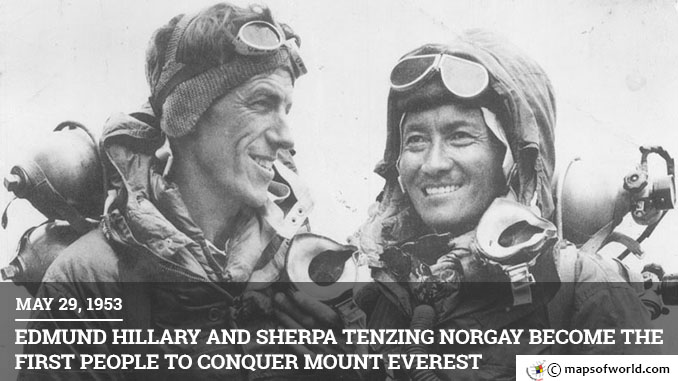At 29,029 feet (8,848 meters), Mount Everest is the highest peak in the world. Mount Everest had long been unconquerable. The Himalayas, themselves, had been forbidding and defied navigation due to the tortuous terrain and Everest in particular was considered the ultimate challenge. In 1924, George Leigh Mallory and Andrew “Sandy” Irvine made a daring attempt to climb to the peak. It shall never be known, however, if they made it to the peak. They were last seen at the Second Step at a height of about 28,000 feet. George Mallory’s body was recovered in 1999. Mount Everest has proved a rather treacherous climb for most mountaineers and climbers. Freezing temperatures, deep crevasses and the potential for a variety of high altitude ailments keep plaguing climbers till this day. Extreme frostbite is one obvious fallout. Those who climb quickly without gradually acclimatizing themselves to the high altitude succumb to “mountain sickness.” Oxygen supply to the human brain is reduced considerably leading to hypoxia. The high altitude prevents the human brain from getting adequate oxygen leading to terrible headaches, lack of clarity in thought, insomnia, loss of appetite, and chronic fatigue. The higher the altitude, the more severe the symptoms may become. At this stage, the climber may experience dementia and a lack of physical coordination, ultimately lapsing into a deep coma. Climbers spend a lot of their time in their ascent of Mount Everest thus slowly acclimating themselves. Food and supplies are always an issue since the high altitude provides the climbers with scarce resources. Most climbers hire Sherpas to help carry their supplies. Sherpas are the locals who often act as guides to the region. In 1953, Edmund Hillary and Tenzing Norgay were chosen to be part of the British Everest Expedition led by Colonel John Hunt. Hunt decided that among the eleven team members, two teams of two members each would attempt to conquer the peak. The first team comprised Tom Bourdillon and Charles Evans and the second team was made up of Edmund Hillary and Tenzing Norgay. On the way up, the team set up nine camps. On May 26, 1953, Bourdillon and Evans made a first attempt to reach the peak and climbed valiantly but could not make it through the final 300 feet due to problems with their oxygen supplies and due to quickly worsening weather. On May 29, Edmund Hillary and Tenzing Norgay had planned to set out at 4:00 am. Weather conditions delayed them and the duo set out at about 6:30 am. After navigating a particularly difficult climb (now known as the Hillary Step), the team managed to reach the summit of Mt. Everest at 11:30 am. Hillary and Tenzing offered the summit food in keeping with local traditions and spent about 15 minutes taking photographs of the view. With the successful descent, news of the conquest quickly brought both Edmund Hillary and Tenzing Norgay into the spotlight for becoming the first people to climb Mount Everest. Also On This Day: 1848 – Wisconsin joins the American Union. 1917 – John F. Kennedy is born. 2004 – The World War II Memorial is dedicated in Washington D.C.
May 29 1953 – Edmund Hillary and Sherpa Tenzing Norgay Become the First People to Conquer Mount Everest
At 29,029 feet (8,848 meters), Mount Everest is the highest peak in the world. Mount Everest had long been unconquerable. The Himalayas, themselves, had been forbidding and defied navigation due…
